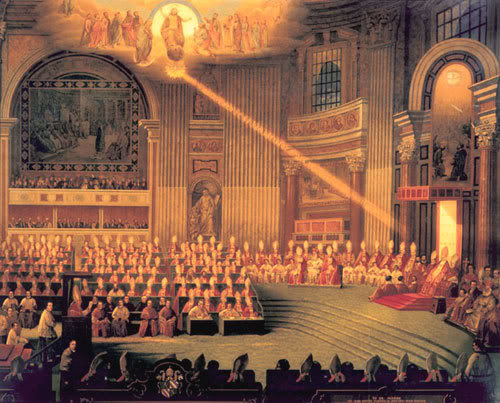
On Dec. 8, 1869, the feast of Mary’s Immaculate Conception in the Catholic calendar, the resoundingly conservative Pope Pius IX opened the First Vatican Council. The following July 18, Pius and the gathering of global bishops climaxed a long-running church struggle and issued a constitution that defines papal authority in the strongest terms.
The upcoming 150th anniversary is a good moment for writers to tap ecumenists, historians, and theologians and ask them point blank: Is it a pipe dream to suppose the world’s Christians will someday, somehow reunite within a single fellowship?
The Second Vatican Council raised hopes with Unitatis Redintegrtio, its 1964 decree on ecumenism. The result is respectful talks and far friendlier relationships among separated churches, but perhaps that’s the best one can hope for. If so, Vatican I is the chief reason. Will your sources will think that’s an overstatement?

Those who’ve heard something about Vatican I will know it proclaimed that the pope is infallible. However, a pope exercises divinely given infallibility only when he defines “a doctrine concerning faith or morals to be held by the whole church” and “speaks ex cathedra.” That Latin phrase, literally “from the chair,” refers to formal exercise of his office’s authority. More broadly, Vatican II declared that Catholics must show “submission of will and of mind” to any authentic teachings by a pope.
In the usual understanding, infallibility applies only when a pope specifies this. This action has been very, very rare, with only one case since Vatican I. See this summary from the U.S. Catholic website:
There is no set list of ex cathedra teachings, but that’s because there are only two, and both are about Mary: her Immaculate Conception (declared by Pope Pius IX in 1854 and grandfathered in after the First Vatican Council’s declaration of papal infallibility in 1870) and her bodily Assumption into heaven (declared by Pope Pius XII in 1950).
But neither of these was earth-shattering to Roman Catholics, because these beliefs had been nurtured through devotion, prayer, and local teaching for centuries before becoming official papal teaching.
Importantly, Vatican I stated that such papal teachings are, and “not by the consent of the church, irreformable,” and pronounced an “anathema” against anyone who dissents.
Eastern Orthodoxy teaches essentially the same belief about one of these doctrines — the Assumption (or Dormition) — but rejects the pope’s personal power to define required dogmas, which should be left to councils of the universal church. For Orthodoxy, the most recent recognized council occurred in A.D. 787. Protestants do not believe in the Assumption because it is not found in the Bible.
Personal infallibility apart from any church consent is only the beginning of the ecumenical problems raised by Vatican One. The council also defined in detail the “immediate” power of a pope, which does not mean timeliness but authority without any intervening earthly power.
The constitution states that Jesus Christ himself granted authority to the apostle Peter, regarded as the first pope, and his successors “hold a world-wide primacy” to “rule and govern the universal church” with “a pre-eminence of ordinary power over every other church.”
All clergy and lay members “are bound to submit to this power” with “true obedience,” not only on “faith and morals” but “the discipline and government of the church throughout the world.” The pope is also “the supreme judge of the faithful” and a “sentence of the apostolic see (than which there is no higher authority) is not subject to revision by anyone.” Contra Orthodoxy, the decree specifies that an ecumenical council has no authority over a pope and that his leadership is not a matter of mere “supervision and guidance.”
Here again, if anyone disagrees “let him be anathema.”
It’s no doubt significant that Pope John Paul II’s 1995 encyclical on Christian unification, which reporters should peruse, affirms a pope’s infallibility “under very specific conditions” but does not delve into the other powers proclaimed by Vatican One.
Practical examples of a pope’s prerogatives are the right to appoint bishops (aided by advisors) for most dioceses around the world, and to choose the officials who govern the universal church with him in the Vatican Curia.
Orthodoxy is very close to Catholicism in theology but it’s hard to imagine it would ever embrace the council’s pronouncements on papal power and jurisdiction, Protestants and the profusion of independent churches in the developing world agree on that and add many other differences, while liberal churches in the West have diverged fon moral issues. Then there’s the debate on women’s role.
So, is Christian reunification dead and this for all time? One of your sources might reply by quoting Jesus: “With God, all things are possible.”











